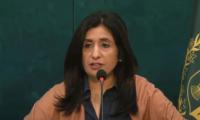ISLAMABAD: In dealing with coronavirus, Sindh has not only taken a lead, it has also taken steps which are benchmarks for other provincial governments. Comparing it with the Punjab, Sindh is at a position once held by the Punjab in the event of a crisis: right decision at the right time and sense of preparedness.
Even top officials in the Punjab would agree. “If there is a province using its own mind and taking independent decision that is Sindh,” said a well-placed bureaucrat in Lahore. Another added: “Sindh is taking decisions and we are only trying to copy. In cases, we do things only because they are being done in Sindh.” Background discussions with officials in both the provinces have found that arrangements in Sindh are far better than steps taken in the Punjab. Right from the arrival of travellers from abroad at airport to their surveillance and treatment of confirmed cases, Sindh has formed policies that are more result-oriented and people-friendly. At the Karachi Airport, for example, there was health staff of the federal government in the beginning. The screening done by that time was not satisfactory.
The passengers were required, under the federal government’s screening arrangement, to submit medical declaration form and undergo thermal scanning. That was enough, Sindh thought. The provincial government deployed its own medial staff that would conduct screening and clinical questions relating to symptoms of corona. Once cleared, the passengers were to receive an advisory containing instructions for the next 14 days. This is not the end of the story. They would daily receive two messages from the provincial government (one in English and Urdu each) for 14 days, asking them to contact at the given numbers in case of cough, fever, pain or respiratory problem.
In contrast, passengers landing at airports in Punjab would only have to go through screening prescribed by the federal government (declaration form and thermal scanning). If cleared, they would go home. Only once, they would receive a call from the provincial government to check if they have any problem and where should they contact in the event of any complaint. No contact afterward unless somebody is tested positive. Even a well-placed Punjab government official admitted that this one-time telephonic screening isn’t helpful in sensitizing suspects about the implications if go unattended.
As far as the identification of suspect patients is concerned, both provinces have different dealing strategy. In Sindh, for example, all private and government hospitals are under instruction to inform district response team as and when they come across a suspect. This team would reach, interview the patient and collect sample for testing. As of to-date, all testing in Sindh is carried out free of cost. If confirmed positive, the patient is granted both options: either to self-isolate at home if he has enough space or get hospitalized.
Only for patients in critical condition, hospitalization is compulsory. Those in home-isolation are regularly contacted for updates and their tests are conducted after a specific time to check whether they have been cured or not. They are cleared after they are confirmed negative twice. Their contacts are traced and also tested to check whether they have contracted infection or not. Whoever is tested positive undergoes the same procedure.
In the Punjab, getting tested positive is not less than a stigma. Whoever has himself tested from whichever place, laboratories are under instruction to report to the health department about positive cases. What happens later becomes an unforgettable story.
Salman Hassan, a British-Pakistani, was the first confirmed case in Punjab. Upon arrival in Pakistan, he had himself tested with Chughtai Lab, which informed the government as he was tested positive. Salman didn’t know this. Following the UK’s National Health Service instructions, he had himself isolated at home but was interrupted at midnight.
“Additional Secretary Health Dr Altaf came to my house at around 12 midnight. It was agreed with him that since it is very late, so I will come to the hospital in the morning. He left my house and waited outside for further instructions from whomever he was reporting to. Then to our total shock, I saw in the (CCTV) camera that there were 3-4 police vans outside my house. I tried to reason with them…I requested sometime so that I could pack a few things…My brother was outside with them and he called me that they are saying that if I don’t come out they will force their way into my house,” he wrote to The News.
This is story of the person who went undetected at the airport and came to know about contracting virus only by having himself tested from a private laboratory. “I think this was very poorly handled by the health department, especially when by their negligence I was cleared at the airport….I am an educated person and I know what precautions to take. Since I had come back to Pakistan on 10th March, I had kept myself in isolation,” he said. Salman was forced to hospital on March 15. Police remained on guard outside his home even after his shifting to hospital.
He is not the only patient policed in Punjab. This is story of every patient. While they are taken away at hospital (even if they have enough space to isolate themselves at home), police stand guard outside the home. Such tactics, it is feared, may lead to under-reporting. It has been observed that many people with symptoms hesitate to get tested fearing such a treatment.
Dr. Zafar Mirza, PM’s Adviser on Health, has also criticized this practice and urged the Punjab to abandon this practice of criminalizing patients. However, health officials in Punjab say that Chinese style of suppression steps are needed to contain the virus. They cite studies suggesting that one of the reasons why virus spread in Italy was isolation at home of the patients. Officials in Sindh in defence of home-isolation refer to the studies of Imperial College, London.







